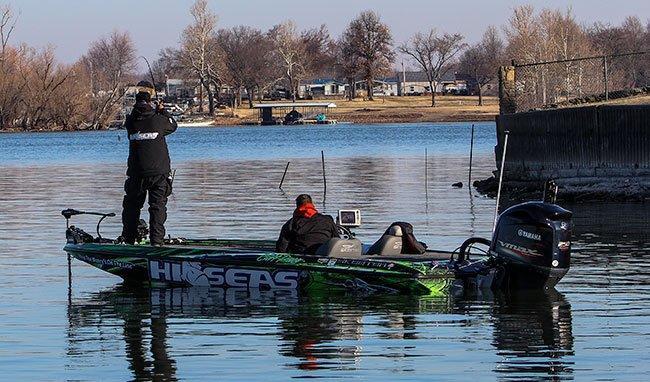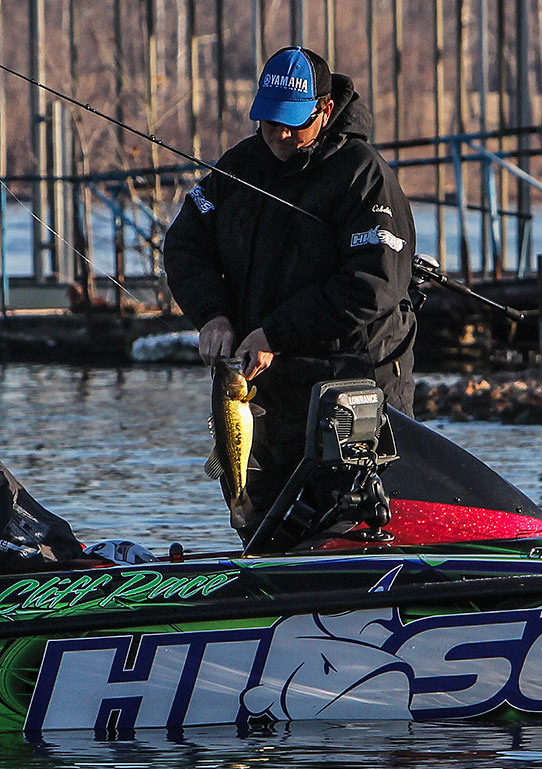Find big bass ambush points fishing wood cover sunk by anglers.
Every angler values some sort of cover when it comes to bass fishing. Some of the easiest cover anglers can make themselves includes brush piles. But sometimes finding already sunk brush can be the key to big catches throughout the year. Understanding the nuances of fishing brush and fishing wood as opposed to rock and grass once you’ve found it often equals big success when bass fishing.
We talked recently with Bassmaster Classic champion Cliff Pace on how he finds good brush and then how he goes about making brush work for him in his bass fishing situations. He shared some great insight that all bass anglers should take to heart when targeting brush on any lake.
The right area makes the brush right
Bass get in brush piles to hide from their prey and sometimes around them because of their prey. But the bass won’t be there if the area isn’t conducive for them.
“For any brush pile to be a good one it’s got to be in the right area,” Pace said. I look for brush piles within my pattern. If I’m fishing main lake points, I will look for brush around those points. Usually I like the brush piles on a good clean hard bottom because that’s what the bass likes.”
Pace looks for three things for a brush pile to be right:
- At the right depth
- Within a pattern
- A good hard bottom
Not all brush is good brush
Bass won’t occupy every brush pile on a lake. In fact, they inhabit a very small percentage of the brush piles on a lake.
“About 25 percent of the brush I find actually holds bass,” Pace said. “So be prepared to find a whole bunch of likely fishing wood that doesn’t hold any bass.”
That’s what he likes about brush pile fishing though. They aren’t just everywhere and the bass aren’t in all of them. So that means when you find a handful of good ones, they will generally always be good ones. And the harder you work to find the right ones, the better your fishing will be when they are in that pattern that the brush is in.
Some lakes produce better brush bass
“Typically I like a lake that doesn’t have a lot of natural cover for fishing brush piles,” Pace said. “If there is grass, and rocks and a lot of manmade structures, brush piles might not be as good as they are on a lake void of a lot of that cover. As they come out of their spawning areas.”
But he will look for brush in his area on all the lakes he fishes. It’s worthwhile to spend the time for what could potentially be a key bite or two if the fishing gets tough.
Keep in mind that brush can be big hardwood trees piled up or single bushy trees or other pieces of wood that forms an object in the water that baitfish relate to and bass use to ambush.
Technology eliminates guess work
Structure Scan has really made finding brush so much easier for anglers.
“It’s really almost not fair anymore,” Pace said. “Instead of guess what the pile looked like and if it had fish near it, you can see how many limbs it has and how many bass are on it with these new Lowrance electronics.”
Pace will spend a lot of time idling an area looking for brush in out-of-the-way places. Instead of simply focusing right on the tip of a point, he idled the bank leading up to it, the curve out of the point, down the side of the point, then up the other side and around into the cove. He’ll make big egg shaped passes around the area looking for brush on the outskirts of the fish holding areas. He often finds the brush that is off to the side of a key spot is the better brush because most folks overlook it.
Once he finds brush he hops up on the deck and makes a few casts until he hits the cover. Then he will immediately get a line up with something on the nearest bank so he can eliminate the guess work when he returns to fish a productive pile.
Fish thoroughly and repetitively
It takes a different array of lures to fish brush versus rock and grass to an extent. The baits that work best often depend on the mood of the bass or season. Pace shared four of his favorites for targeting brush:
- 3/8-ounce V&M Football Jig (Classic winning jig)
- Texas-rigged V&M Pork Pin
- Jackall Muscle Deep or MC/60 crankbait
- 1/2-ounce V&M Cyclone Classic Platinum Spinnerbait
When the fish are in the brush, he will work a jig or a worm up and over every branch slowly, trying to make as much contact with the cover as he can on one cast. Many bites will occur just as the lure comes up and over a branch and starts falling again. So it’s important to be a line watcher and feel for the bites as it the lure falls through the cover.
If the fish are aggressive, especially in warmer summer months, he will go for a reaction bite by crashing a crankbait into limbs and the top of trees he’s fishing. It takes some practice but you can actually get good at worming a crankbait through the brush with your rod and triggering some big fish to bite.
And before he leaves any brush pile he always makes a few casts to it with a spinnerbait. He feels like it’s one of the best ways to trigger an aggressive bass to bite around brush. It’s been a go to big fish producer for years for him in the warmer months.
It’s worth your time to explore your lake and rule out the unproductive brush piles and find those handful of fish producers to always have in your back pocket on a tough day or when you don’t have time to run around and find bass, knowing a handful of good brush piles can be a fishing day saver. Fishing brush takes patience but the rewards can be huge in bass fishing.













